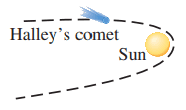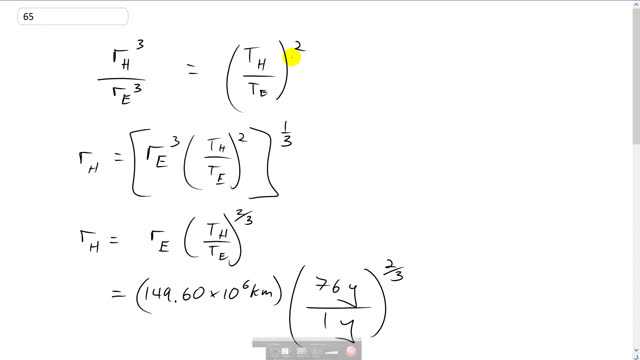
Halley’s comet orbits the Sun roughly once every 76 years. It comes very close to the surface of the Sun on its closest approach (Fig. 5–45). Estimate the greatest distance of the comet from the Sun. Is it still “in” the solar system? What planet’s orbit is nearest when it is out there?


In order to watch this solution you need to have a subscription.
This is Giancoli Answers with Mr. Dychko. The orbital radius of Halley's comet cubed divided by the orbital radius of Earth cubed equals the orbital period of Halley's comet divided by the orbital period of Earth squared. And we are using Earth as a point of comparison because we know everything about Earth; we know its orbital radius and its period. And so we'll figure out the orbital radius of Halley's comet, by multiplying both sides by r E cubed and then raise both sides to the exponent one-third, which is also the same as doing cube root. And so r E cubed to the power one-third becomes r E and then this ratio of period's becomes to the power of 2 over 3; 2 times a third makes 2 over 3. So, we have 149.6 times 10 to the 6 kilometers— orbital radius of Earth— times 76 years divided by 1, which is just 76. to the power of 2 over 3 makes 2.684 times 10 to the 9 kilometers, that's r H. Now, what is that r H really? This r in Kepler's law is the semi-major axis, which means it's half of the full half of the major axis. So the major axis is the largest distance you can get in an ellipse; it's the length of the longest point-to-point, the greatest distance you can possibly get in an ellipse, that's the major axis. And this r is the semi-major axis, semi meaning halves and you know, semi-circle is half a circle so semi-major axis means half of this major axis. And, we are told that Halley's comet passes really close to the Sun here so we can approximately say, that this point is at the Sun. In which case, the furthest distance from the Sun is going to be 2 times this semi-major axis. So the full distance from here to the Sun is gonna be 2 times r, approximately. So, that's 2 times 2.684 times 10 to the 9 kilometers and that gives 5.4 times 10 to the 9 kilometers and that's still in the solar system because Pluto is about 5.9 times 10 to the 9 kilometers. And so, there we go!